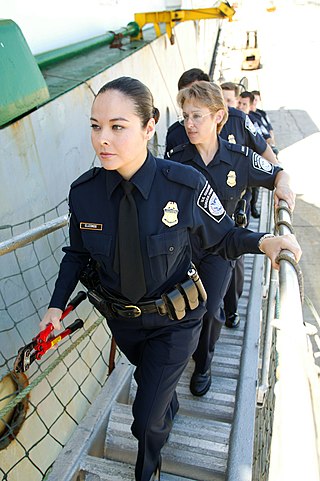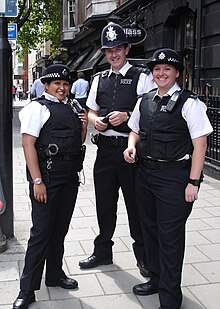
The United States Coast Guard (USCG) is the maritime security, search and rescue, and law enforcement service branch of the United States Armed Forces and one of the country's eight uniformed services. The service is a maritime, military, multi-mission service unique among the United States military branches for having a maritime law enforcement mission with jurisdiction in both domestic and international waters and a federal regulatory agency mission as part of its duties. It is the largest coast guard in the world, rivaling the capabilities and size of most navies.
The United States has eight federal uniformed services that commission officers as defined by Title 10 and subsequently structured and organized by Titles 10, 14, 32, 33, and 42 of the U.S. Code.

The surgeon general of the United States is the operational head of the United States Public Health Service Commissioned Corps (PHSCC) and thus the leading spokesperson on matters of public health in the federal government of the United States. The Surgeon General's office and staff are known as the Office of the Surgeon General (OSG), which is housed within the Office of the Assistant Secretary for Health.

Military police (MP) are law enforcement agencies connected with, or part of, the military of a state. In wartime operations, the military police may support the main fighting force with force protection, convoy security, screening, rear reconnaissance, logistic traffic management, counterinsurgency, and detainee handling.

The National Oceanic and Atmospheric Administration Commissioned Officer Corps, known informally as the NOAA Corps, is one of eight federal uniformed services of the United States, and operates under the National Oceanic and Atmospheric Administration (NOAA), a scientific agency overseen by the Department of Commerce. The NOAA Corps is made up of scientifically and technically trained officers. The NOAA Corps and the United States Public Health Service Commissioned Corps are the only U.S. uniformed services that consist only of commissioned officers, with no enlisted or warrant officer ranks. The NOAA Corps' primary mission is to monitor oceanic conditions, support major waterways, and monitor atmospheric conditions.
First lieutenant is a commissioned officer military rank in many armed forces; in some forces, it is an appointment.
The United States service academies, also known as United States military academies, are federal academies for the undergraduate education and training of commissioned officers for the United States Armed Forces.
Ensign is a junior rank of a commissioned officer in the armed forces of some countries, normally in the infantry or navy. As the junior officer in an infantry regiment was traditionally the carrier of the regimental colours, the rank acquired the name. This rank has generally been replaced in army ranks by second lieutenant. Ensigns were generally the lowest-ranking commissioned officer, except where the rank of subaltern existed. In contrast, the Arab rank of ensign, لواء, liwa', derives from the command of units with an ensign, not the carrier of such a unit's ensign, and is today the equivalent of a major general.

The United States Public Health Service Commissioned Corps, also referred to as the Commissioned Corps of the United States Public Health Service, is the uniformed service branch of the United States Public Health Service (PHS) and one of the eight uniformed services of the United States alongside the United States Army, Navy, Marine Corps, Coast Guard, Air Force, and Space Force and the NOAA Commissioned Officer Corps. The commissioned corps' primary mission is the protection, promotion, and advancement of health and safety of the general public.

The Vice Presidential Service Badge is an identification badge of the United States Armed Forces which is awarded to members of the U.S. Army, U.S. Navy, U.S. Air Force, U.S. Space Force, U.S. Marine Corps, and U.S. Coast Guard as well as other members of the uniformed services, such as the U.S. National Oceanic and Atmospheric Administration Commissioned Corps and the U.S. Public Health Service Commissioned Corps, who serve as full-time uniformed service aides to the vice president. It was established under Executive Order 11544 by President Richard Nixon on July 8, 1970 and was modified by President Gerald R. Ford on July 19, 1976 under Executive Order 11926.

Identification badges of the uniformed services of the United States are insignia worn by service members conducting special duties, many of which can be awarded as permanent decorations if those duties are performed successfully. There are a few identification badges that are awarded to all services, others are specific to a uniform service. The Office of the President and Vice President and department/service headquarters badges are permanent decorations for those who successfully serve in those assignments. Some of the service level identification badges can be permanent decorations and others are only worn by a service member while performing specific duties, such as the Military Police Badge.

A Marine Security Guard (MSG), also known as a Marine Embassy Guard, is a member of the Marine Corps Embassy Security Group, a brigade-sized organization of the United States Marine Corps (USMC) whose detachments provide security at American embassies, consulates, and other official U.S. government offices, such as the United States Mission to NATO in Brussels, Belgium.

A border guard of a country is a national security agency that performs border security. Some of the national border guard agencies also perform coast guard and rescue service duties.
In the uniformed services of the United States, captain is a commissioned-officer rank. In keeping with the traditions of the militaries of most nations, the rank varies between the services, being a senior rank in the naval services and a junior rank in the ground and air forces. Many fire departments and police departments in the United States also use the rank of captain as an officer in a specific unit.
Law enforcement in Spain is carried out by numerous organizations, not all of which operate in the same areas.

A rear admiral in the uniformed services of the United States is either of two different ranks of commissioned officers: one-star flag officers and two-star flag officers. By contrast, in most other countries, the term "rear admiral" refers only to an officer of two-star rank.

In many countries, particularly those with a federal system of government, there may be several law enforcement agencies, police or police-like organizations, each serving different levels of government and enforcing different subsets of the applicable law.

The federal government of the United States empowers a wide range of federal law enforcement agencies to maintain law and public order related to matters affecting the country as a whole.

An officer is a person who holds a position of authority as a member of an armed force or uniformed service.













